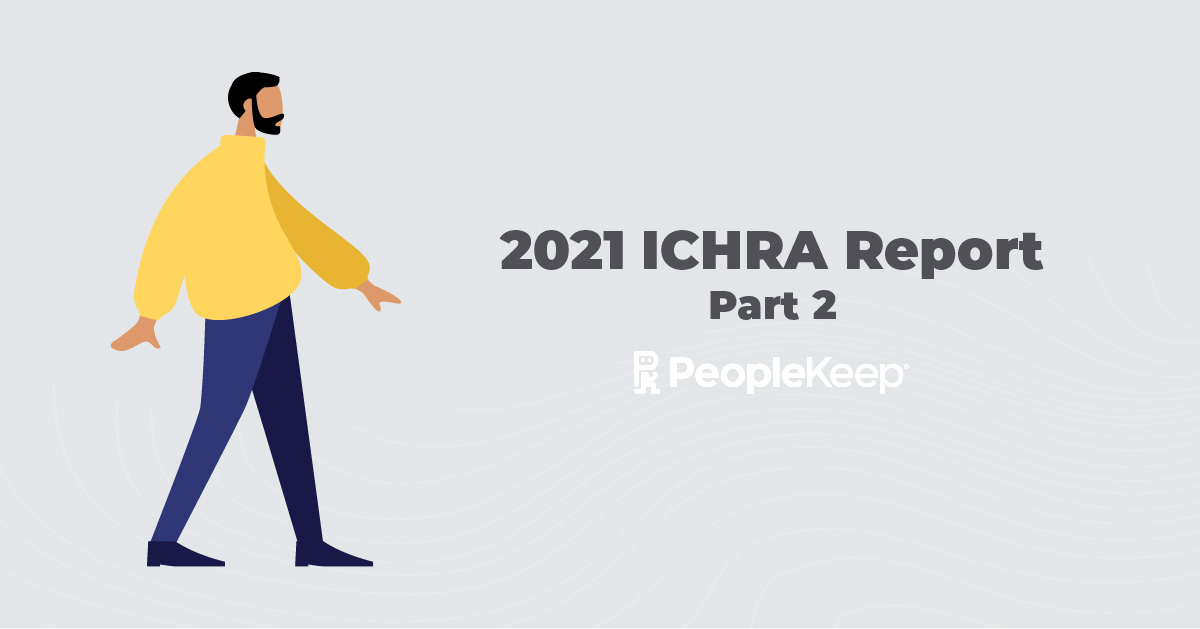What we learned in the first 90 days of the individual coverage HRA
By Alex Flitton on April 15, 2020 at 6:00 AM
The long-anticipated individual coverage HRA (ICHRA) finally went into effect on January 1, 2020. Since then, PeopleKeep has worked with hundreds of employers throughout the United States to aid in the administration of the health benefit.
In this article, we review how employers and their employees have used the benefit in the first 90 days of its availability.
Benchmarking ICHRA allowance averages
One of the appeals employers find in the ICHRA is the lack of allowance caps that QSEHRA users must follow. In 2020, employers offering the QSEHRA are restricted to offering single employees $5,250 per year ($437.50/mo). For employees with a family, employers are restricted to $10,600 ($883.33/mo). ICHRA users, on the other hand, are able to set whatever allowance they like and offer it to specified employee classes.
In our 2020 QSEHRA annual report, we found that employers throughout the United States offered an average of $3,360 per year to single employees, and $6,168 per year to employees with a family. In fact, employers offering the QSEHRA offered 61% of the total allowance the government allowed. Now let’s compare employers offering the ICHRA without an allowance cap.
The average ICHRA allowance amount in the first 90 days
In the first 90 days of the ICHRA’s availability, employers offered an average of $5,971 ($743 per month) to single employees, and $12,892 ($1,074 per month) to employees with a family. That is more than 1.8x the average allowance offering for single employees using the QSEHRA in 2019, and 2.6x the average allowance for employees with a family.
| QSEHRA (2019) | ICHRA (First 90 Days) | |||
| Annual Totals) | Single | Family | Single | Family |
| Allowance cap | $5,150 | $10,450 | Unlimited | Unlimited |
| Average allowance | $3,360 | $5,971 | $5,971 | $12,892 |
| Percentage of cap | 65% | 47% | N/A | N/A |
Premium-only vs. premium-plus
PeopleKeep offers employers the option to choose between reimbursing premiums exclusively, or including out-of-pocket expenses. Within the first 90 days, the board was split nearly in half, with 48% of employers opting for the premium-only ICHRA, and 52% choosing to also cover out-of-pocket expenses.
Comparing ICHRA allowance amounts
In the first 90 days, employers offering the premium-only ICHRA offered an average annual allowance of $5,544 ($462 per month) to employees. Employers offering the premium-plus ICHRA, however, offered an impressive $17,292 per year ($1,441 per month) to employees. Considering that the nationwide average premium cost for individual health insurance is $5,280 per year ($440 per month) for individuals and $14,016 per year ($1,168 per month) for families, the average employee has enough ICHRA allowance to exceed the average cost of health insurance.
| ICHRA allowances (first 90 days). | Average premium cost (2020). | ||
| Premium-only | Premium-plus | Individuals | Families |
| $5,544 | $17,292 | $5,280 | $14,016 |
Average allowance amount by company size
The trend we are seeing with current ICHRA users largely shows that ‘micro’ employers with only a few employees in a certain class offer a much higher allowance than larger employers.
Opt-in rate for the ICHRA
The ICHRA also has a strong appeal with employees. Employees have the chance to opt out of the benefit to use premium tax credits instead. We did see, however, that 75 percent of all employees who are offered the ICHRA remain opted into the benefit.
Considering it’s a brand new health benefit, and is much less common than group health insurance, the adoption rate is quite impressive, especially considering the minimum required opt-in rate for group health insurance is 70%.
Most common employee classes
ICHRA users enjoy the benefit of being able to set different allowance amounts based on 11 different employee classifications. In addition to 10 of the original classes, employers are able to combine any of the classes to form an 11th.
In the first 90 days, the most commonly used employee classes are:
- Full-time, salaried
- Full-time
- Salaried
We have also seen strong interest in creating an employee class for employees in a different state than the main headquarters where employees often have a group health plan that doesn’t extend well to the new satellite office location.
Most common out-of-pocket expenses
Finally, we found that identical to the QSEHRA, the most common out-of-pocket expenses submitted for reimbursement were:
- Prescription drugs - 61% of submitted expenses
- Medical office visits - 13% of submitted expenses
- Chiropractic care - 5% of submitted expenses
Conclusion
Within the first 90 days, we are excited to see the ICHRA performing so well. Hundreds of employers throughout the United States are offering the brand new benefit through PeopleKeep, and employees are engaging at a high rate. Looking ahead, we are confident that engagement will only increase as employees understand the health benefit better. As we enter the summer and companies begin to actively consider their health benefit program for 2021, we anticipate accelerated demand to examine the ICHRA.
Check out more resources
See these related articles

Pros and cons of the individual coverage HRA
Considering an individual coverage HRA (ICHRA)? Discover the pros and cons of this healthcare option to make an informed decision.

How HRAs work for spouses and dependents
Learn about the eligibility and benefits of health reimbursement arrangements (HRAs) for spouses and dependents in this comprehensive overview.

2021 ICHRA Report
Get an inside look at how employers are using their individual coverage HRA, complete with data on allowance amounts, class sizes, expenses, and more.


